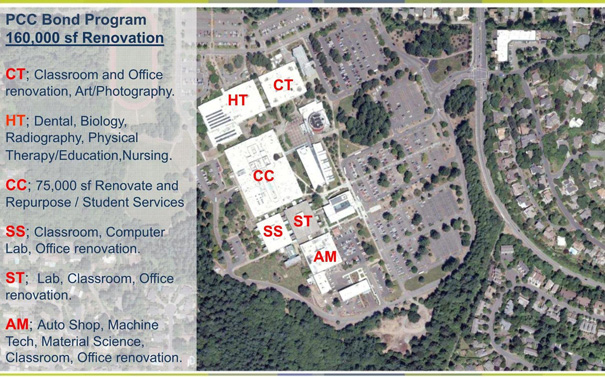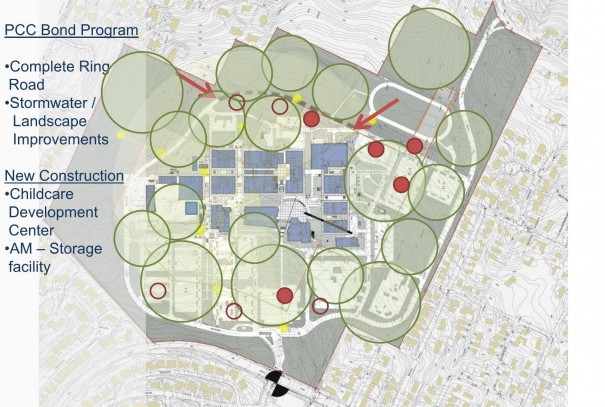This content was published: November 5, 2010. Phone numbers, email addresses, and other information may have changed.
Sylvania Campus outlines upcoming improvements to neighbors and staff at community meeting
Photos and story by Gina Whitehill-Baziuk
PORTLAND, Ore. – Portland Community College’s oldest campus is about to get a facelift.
At 42 years old, PCC’s Sylvania Campus is embarking on a five to seven-year construction project that will result in a modernized, energy-efficient campus. Initial design plans and concepts were shared Oct. 27 at a community forum that was attended by immediate neighbors to the campus, representatives from nearby neighborhood associations and interested faculty and staff.
“Sylvania is known for its vintage, concrete 1968 buildings that were constructed when energy prices were considerably lower,” said Linda Gerber, president of Sylvania Campus. “These are not energy efficient buildings, nor do they offer our students the best learning environment.”
Funding for construction stems from a $374 million bond measure that voters approved in 2008 to upgrade existing buildings, expand work-force training facilities and add needed buildings at PCC’s campuses throughout the district.
The architectural design efforts for the Sylvania Campus are being led by GBD Architects. According to PCC’s bond Project Manager Gary Sutton, approximately $55 million to $60 million will be pumped into the Sylvania Campus to renovate 160,000 square feet of classroom, laboratory and office space.
“The largest project will be modernizing nearly 75 percent of the College Center building, transforming it into an accessible, easy-to-navigate student union,” said Sutton.
Other projects include building a new childcare development center and a storage facility for the automotive building; completing a road around the campus to enhance accessibility in case of emergencies; and improving storm water management and way-finding on campus.
“The complexity of this is really the coordination of logistics – of what project to begin, when, so that we create the least amount of disruption and can continue operating as usual, for students and staff,” said Jeff Triplett, Sylvania’s dean of instruction and campus liaison to the project. To achieve this, most construction work will be done during the summer months when there are fewer students on campus.
Key to all of this activity will be creating an educational component for students, so that faculty build activities and homework into their curriculum as the work is under way. To ensure this, Triplett is working with campus division deans to create a Green Initiative Fund. One-time funds will be available to enable single classes, or a consortium of classes, to participate in learning activities as part of bond-funded construction.
“We want this to be a learning laboratory, where instructors find ways to develop course materials and projects that complement the work of our architects, landscape designers, structural engineers and other contractors involved, so students soak it all up and really benefit from the experience,” Triplett said. “The Green Initiative Fund will help to pave the way for this to happen.”
Simultaneous to bond-funded improvements being rolled out at Sylvania is the campus’ goal of getting on the “path to Net Zero” – meaning, to create a campus that generates its own energy, collects its own water needs and treats its own waste. The project also is referred to as “E6” – for energy creation; energy conservation; environmental stewardship; employment stimulus; education; and effective and efficient use of funds.
The idea was launched in 2009 when Gerding Edlen Sustainable Solutions was brought on to conduct a study of Sylvania and determine what it would take to make the aging campus Net Zero. A handful of multi-phase options were developed and presented for consideration; the option chosen – which will be woven into bond-funded improvements – includes building and water efficiency measures, and energy creation by way of a mega-watt co-generator. Together, they are anticipated to create an annual savings estimated at $1.2 million.
“We’re looking at the Net Zero/E6 project as a model for innovative strategies and practices to address climate change, environmental stewardship and green workforce development,” Gerber said. “To marry this with bond-funded improvements slated for Sylvania will offer incredible learning opportunities for our students – and the community at large benefits from this.”
Meanwhile, Sylvania Campus administrators, PCC’s bond team and GBD Architects are hosting visioning sessions, charrettes and symposiums with faculty, staff and students to get input and suggestions about what works well, areas for improvement and opportunities for interactive sharing as it creates a design framework for bond-funded campus improvements.
“We want to develop a schematic that provides greater accessibility, flexible and adaptable common spaces, introduces natural daylight indoors and creates intuitive way-finding on campus,” said Kyle Andersen, one of the lead GBD architects on the project. “Integrated throughout will be ongoing engagement with staff and students.”
The Sylvania Campus– which straddles Portland, Tigard and Lake Oswego – is PCC’s largest campus, with 30,430 full-and part-time students. This represents an increase of nearly 18 percent over the past decade. Collectively, the college serves more than 90,000 students – more than every school in the Oregon University System combined.


